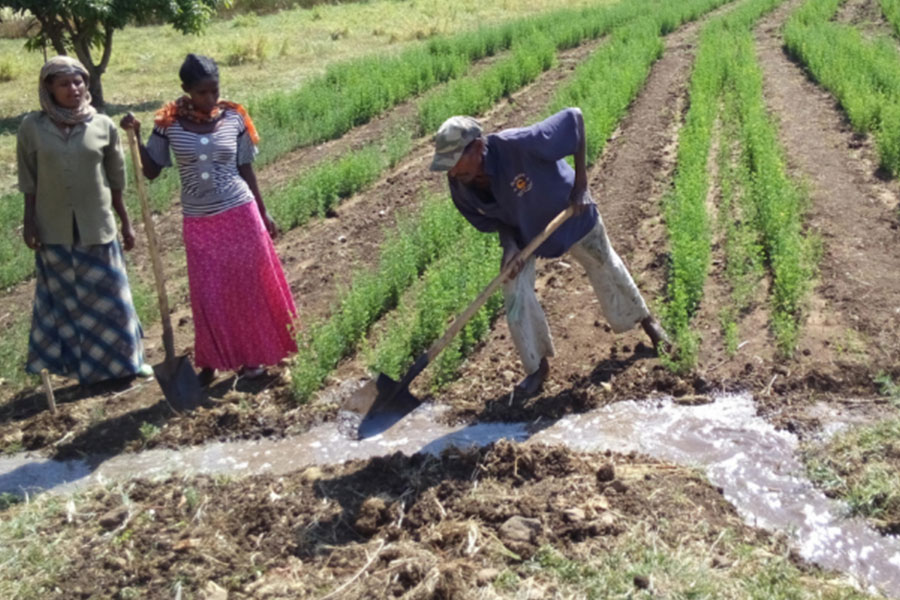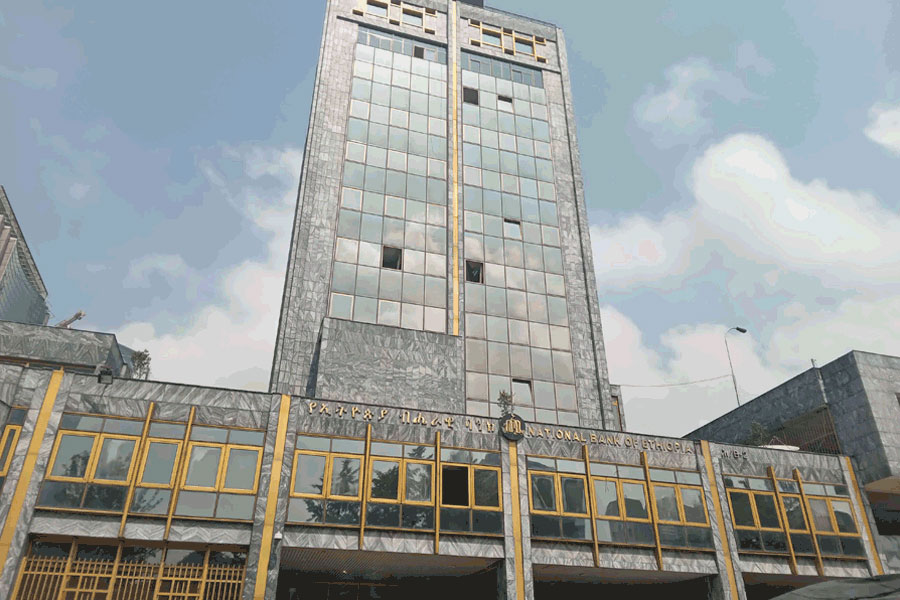
Fortune News | Apr 09,2022
Jan 13 , 2024
By AKSAH ITALO ( FORTUNE STAFF WRITER )
The federal government is undertaking a major reassessment of its water resource management policy and irrigation infrastructure, responding to the escalating threat of droughts.
At the centre of this strategic shift is the Ministry of Irrigation & Lowlands, overseeing 27 irrigation projects. However, only 17 projects were under construction as of July 2023. The Ministry’s efforts have been deterred by various constraints, including design reviews, construction delays, and suspending five projects due to security concerns.
Despite Ethiopia's growing population and the impacts of climate change, several irrigation schemes have fallen short of their objectives. A notable example is the project in southern Gonder, Amhara Regional State, where 16 irrigation dams were expected to support the production of wheat, onion, teff, and cabbage for 35,000 farmers over an 11,058hct plot. Like many others, the project failed to meet its goals, leaving the farmers without the anticipated benefits.
The dependence on rainfed agriculture in regional states like Amhara has resulted in significant crop failures, especially during dry seasons. Demsew Mulualem, an expert at the region's Agriculture Bureau, drew attention to a project that remains in limbo. Delayed for a decade, it was designed to water approximately 20,000hct.
Yared Mulat, the Ministry's head of irrigation research, identifies a significant gap in standardisation as a primary factor behind these projects' failures. He blamed the absence of national standards and codes for geotechnical investigations, leading to delays, cost overruns, and project failures. Yared advocates for introducing new standards and procedural manuals for irrigation project designs, including soil earthwork analyses, to address the persistent problems.
"These should have been implemented long ago," he told Fortune.
Even the completed projects are not immune to problems. Many are dysfunctional due to construction issues, a problem acknowledged by Bizuneh Tolcha, the Ministry's communications director. While Bizuneh was keen on promoting the Ministry’s successes in covering 1.45 million hectares in the past three years and its plans for an additional 400,000hct this year, he conceded that issues like proper utilisation of plots and security concerns are beyond control.
"It's beyond our mandate," Bizuneh told Fortune.
The droughts have hit smallholder agropastoralist farmers in lowlands areas, constituting 62pc of the country's total landmass, particularly hard. These have led to widespread food insecurity and increased reliance on aid. According to the UN Humanitarian Coordination Office, 28.6 million people across several regional states are in need of humanitarian assistance. Targeting half of these will demand four billion dollars in spending.
Dida Kare, a farmer in Borena Zone, Oromia Regional State, presents the plight of the people behind the statistics. Having lost 90 of his 100 cattle to drought, he now relies on aid to feed his family.
"My children don't have enough to eat," he told Fortune.
Dida has been adjusting poorly to this new life of handouts, with his final 10 cattle wasting and his children's throats parched with the bit of water he scrapes up daily. No less than three million cattle perished in Borena Zone, which has been one of the hardest-hit regions, due to four years of failed rainy seasons since 2020, affecting 13 million people.
Kiya Arero, a senior expert at the Oromia Agricultural Bureau, disclosed that of the six completed irrigation projects in Borena, only one is operational, limiting irrigated land to a mere 63hct out of a potential 8,080hct.
"Severe water shortage has taken many lives," said Kiya. "The land was primarily used to grow animal feed, which requires rainy seasons".
Officials attribute the absence of timely and dependable weather forecasts as a major obstacle.
"Recurrent drought is affecting regional states," acknowledged Solomon Wakagari, a senior advisor at the Ministry.
He believes the drawback led to a high dependence on aid, with interventions often lagging behind needs. Despite the belated responses, the international aid community is trickling funds.
A five-million-dollar drought resilience project funded by the United States government has been launched to improve adaptive capacity and coordinate development. State Minister Endrias Geta, during the project's launch, acknowledged that 90pc of livestock exports come from the lowlands and admitted that lack of attention to these areas had fueled several problems. The project aims to improve drought resilience in the face of climate change-induced shocks.
However, Dubale Admasu, head of these projects in Tigray, Amhara, Afar, and Southern regional states, said fragmented coordination among participants was a primary cause for the absence of streamlined policy creation and implementation.
Operating with a budget of 10 billion Br, the Ministry has also sought financing, including a recent project fund from the African Development Bank (AfDB). Projected at 4.5 billion Br, the money is budgeted to construct irrigation dams in the Amhara, Oromia, and Sidama regional states, covering nearly 10,000hct. Four local contractors (Yoseph Teketel, Ayalew-Addisu, Bershacon Construction Plc. and Ethiopian Construction Works Corporation) have been awarded, and the work is projected to be completed in two years.
Experts like Aniley Tesfay, a lecturer in water resources and environmental engineering at Gondor University, promote the idea of well-designed irrigation infrastructures and a skilled workforce. They argue that these are essential to address the population's vulnerability to drought. Factors such as sedimentation, climate change, dam storage capacity, and rainfall variability are often inadequately considered, contributing to the dysfunctionality of many irrigation projects.
"Irrigation is the lifeblood of agricultural productivity," said Aniley.
According to him, failure to collect site-specific and reliable hydrological data and poorly designed procedures are lingering issues.
PUBLISHED ON
Jan 13,2024 [ VOL
24 , NO
1237]

Fortune News | Apr 09,2022

Radar | Jul 27,2019

Fortune News | Sep 02,2023

Radar | Apr 30,2022

Radar | Apr 16,2022

Viewpoints | Jun 07,2020

Fortune News | Mar 30,2019

Fortune News | Dec 28,2019

Radar | Jan 28,2023

Fortune News | Jun 07,2020

Dec 22 , 2024 . By TIZITA SHEWAFERAW
Charged with transforming colossal state-owned enterprises into modern and competitiv...

Aug 18 , 2024 . By AKSAH ITALO
Although predictable Yonas Zerihun's job in the ride-hailing service is not immune to...

Jul 28 , 2024 . By TIZITA SHEWAFERAW
Unhabitual, perhaps too many, Samuel Gebreyohannes, 38, used to occasionally enjoy a couple of beers at breakfast. However, he recently swit...

Jul 13 , 2024 . By AKSAH ITALO
Investors who rely on tractors, trucks, and field vehicles for commuting, transporting commodities, and f...

Oct 25 , 2025
The regulatory machinery is on overdrive. In only two years, no fewer than 35 new pro...

Oct 18 , 2025
The political establishment, notably the ruling party and its top brass, has become p...

Oct 11 , 2025
Ladislas Farago, a roving Associated Press (AP) correspondent, arrived in Ethiopia in...

Oct 4 , 2025
Eyob Tekalegn (PhD) had been in the Governor's chair for only weeks when, on Septembe...